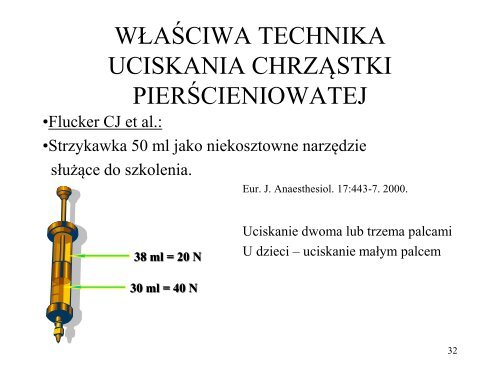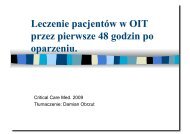laryngoskopia bezpoÅrednia
laryngoskopia bezpoÅrednia
laryngoskopia bezpoÅrednia
- No tags were found...
You also want an ePaper? Increase the reach of your titles
YUMPU automatically turns print PDFs into web optimized ePapers that Google loves.
Resonant Ultrasound Spectroscopy 157with modern, freely-available software packages such as Lapack(Anderson et al. 1999). Both K and E are real and symmetric, andK is positive definite. For any energetically-stable material, the elasticenergy matrix E will be non-negative definite. These conditionsguarantee that the eigenvalues of 8 will be non-negative. In factthere will be six zero eigenvalues, corresponding to three degrees ofrigid-body translation and three degrees of rigid-body rotation, andall of the rest will be positive, corresponding to elastic resonances.The devil in Rayleigh–Ritz methods often lies in the details of thebasis functions, φ λ (r). The first studies used trigonometric functions(Holland 1968) and orthogonal polynomials (Demarest 1969) tailoredto a rectangular sample shape. These choices promised goodnumerical efficiency, in the one case because the trigonometric functionsmimicked the basic wave-like nature of the elastic displacementfields and in the other case because the orthogonal polynomialswere known to have good numerical stability. On the other hand theyrequired substantial effort to formulate and programme the variousintegrals, and the effort would be needed afresh for each new samplegeometry and symmetry.These choices were appropriate in an environment in which algebraicand programming effort was regarded as cheaper than computertime. The major contribution of Visscher et al. (1991) was thediscovery that the simplest possible choice of φ λ , namely monomialsof the formφ λ = x η(λ) y ζ (λ) z ξ(λ) , (9)where η, ζ , and ξ are positive integers, could provide a basis that wasboth numerically adequate (given the great advances in computingpower) and very flexible and convenient to implement for a widevariety of shapes V and symmetries. In fact, with a little attentionto scaling (Maynard & So 1991) it is numerically much more thanadequate.We still have to choose the set of exponents {η, ζ , ξ}. The mostcommon practice is to choose some positive integer N P and use theset of all values satisfyingη + ζ + ξ ≤ N P (10)The larger N P , of course, the more accurate the results. For a givenN P there are( )NP + 33 = (N P + 1)(N P + 2)(N P + 3)/2 (11)3basis elements counting all three components of u. The size of theproblem, the length of α, grows as N 3 P. Since the computationaleffort required to solve 8 scales as the cube of the length of α, thateffort grows as N 9 P .An alternative scheme is to restrict the individual ranges of thethree indices to be proportional to some measure of sample size inthe dimensions. This approach tries to roughly spread the resolutionof the basis around in a way that recognizes the wavelike nature ofthe solution, and is probably the better choice. Our experience isthat both are satisfactory.Our task now is to compute the components of K and E, and thento solve the resultant generalized eigenvalue problem for its eigenvaluesand eigenvectors. Each eigenvalue is the squared angularfrequency of a resonance and its eigenvector comprises the coefficientsof the basis functions for the resonance displacement field.To properly formulate this we have to sort out some bookkeepingissues.Recall that α is a vector containing all of the coefficients for all ofthe components of u. Each element in α is one of the elements fromthe vector of coefficients a for one of the cartesian components ofu. Use λ as an index into α. For each value of λ, we must keep trackofi(λ) the Cartesian component of u to which α λ appliesη(λ) the exponent of x in φ λζ (λ) the exponent of y in φ λξ(λ) the exponent of z in φ λ .Then∫K = 1 2K λλ ′ = 1 2= 1 2V∫ρu i u i dv (12)Vρα λ x η(λ) y ζ(λ) z ξ(λ) δ i(λ)i(λ ′ ) (13)× α λ ′ x η(λ′) y ζ (λ′) z ξ(λ′) dv (14)∫Vρx η(λ)+η(λ′) y ζ (λ)+ζ (λ′) z ξ(λ)+ξ(λ′) dv (15)There is an analogous but messier expansion for E. In both cases theresults look messier than they are. Each consists of a bookkeepinghair-shirt wrapped around integrals of the form∫f (x, y, z)x l y m z n dv (16)Vwhere f (x, y, z) is either density or one of the Cartesian componentsof the elastic stiffness tensor. In any region S ⊆ V in which f (x, y,z) can be written as a sum of monomial basis functions, a conditionthat includes the nearly universal case of being constant in S, all ofthe integrals we need are of the form∫I S (l, m, n) = x l y m z n dv (17)SUsually, SisV.InAppendix B we give explicit results for I S forthe cases of a rectangular parallelepiped, an ellipsoidal cylinder, atriaxial ellipsoid, and a right-circular cylindrical wedge.Eq. (8) can be further simplified for its numerical evaluation. Inthe orthorhombic and higher symmetry case, we can order matricesK and E in such a way to make them block diagonal. There arethen 8 diagonal blocks. Instead of (numerically) solving for a largeeigenvalue problem, we now solve for 8 smaller ones. See A forfurther details.3.2 Elastic energy and dampingWe shall need to know how perturbations in the sample’s materialproperties, ρ and, particularly, C, affect its resonance frequencies.The results of this calculation are also useful in the special case thatperturbations in C are imaginary, in which instance the results tellus how anelasticity in the sample contribute to the total dissipationor Q of each resonance.In order to make this computation we must appeal to Rayleigh’sPrinciple, famously stated in Article 88 of Rayleigh (1896, 1945re-issue), which tells us how to compute the perturbed eigenvaluesof a perturbed hermitian operator without computing the perturbedeigenvectors. (This is really just standard first-order perturbationtheory for hermitian operators—see for instance chapter 10 of Mathews& Walker 1965—but it’s more fun to get it from Rayleigh.) Thisresult says that if we perturb the matrices K and E in 8 thusK → K + δK (18)E → E + δE, (19)C○ 2004 RAS, GJI, 156, 154–169





![Znieczulenie w trybie ratunkowym [739 kB]. - Waldemar MachaÅa](https://img.yumpu.com/50055819/1/190x135/znieczulenie-w-trybie-ratunkowym-739-kb-waldemar-machaaa.jpg?quality=85)



![[18,3 MB]. Autor: Waldemar MachaÅa](https://img.yumpu.com/49459590/1/190x135/183-mb-autor-waldemar-machaaa.jpg?quality=85)

![Stany zagrożenia życia w poÅożnictwie [5,91 MB]. Autor](https://img.yumpu.com/49016512/1/190x135/stany-zagroa-1-4-enia-a-1-4-ycia-w-poaoa-1-4-nictwie-591-mb-autor.jpg?quality=85)


![Monitorowanie czynnoÅci OUN [11,2 MB]. WykÅad z kursu ...](https://img.yumpu.com/46011988/1/190x135/monitorowanie-czynnoaci-oun-112-mb-wykaad-z-kursu-.jpg?quality=85)

